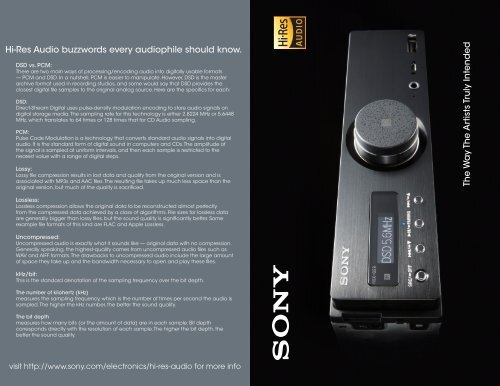Hi-Res Audio Catalog
You also want an ePaper? Increase the reach of your titles
YUMPU automatically turns print PDFs into web optimized ePapers that Google loves.
<strong>Hi</strong>-<strong>Res</strong> <strong>Audio</strong> buzzwords every audiophile should know.<br />
DSD vs. PCM:<br />
There are two main ways of processing/encoding audio into digitally usable formats<br />
— PCM and DSD. In a nutshell, PCM is easier to manipulate. However, DSD is the master<br />
archive format used in recording studios, and some would say that DSD provides the<br />
closest digital file samples to the original analog source. Here are the specifics for each:<br />
DSD:<br />
Direct-Stream Digital uses pulse-density modulation encoding to store audio signals on<br />
digital storage media. The sampling rate for this technology is either 2.8224 MHz or 5.6448<br />
MHz, which translates to 64 times or 128 times that for CD <strong>Audio</strong> sampling.<br />
PCM:<br />
Pulse Code Modulation is a technology that converts standard audio signals into digital<br />
audio. It is the standard form of digital sound in computers and CDs. The amplitude of<br />
the signal is sampled at uniform intervals, and then each sample is restricted to the<br />
nearest value with a range of digital steps.<br />
Lossy:<br />
Lossy file compression results in lost data and quality from the original version and is<br />
associated with MP3s and AAC files. The resulting file takes up much less space than the<br />
original version, but much of the quality is sacrificed.<br />
The Way The Artists Truly Intended<br />
Lossless:<br />
Lossless compression allows the original data to be reconstructed almost perfectly<br />
from the compressed data achieved by a class of algorithms. File sizes for lossless data<br />
are generally bigger than lossy files, but the sound quality is significantly better. Some<br />
example file formats of this kind are FLAC and Apple Lossless.<br />
Uncompressed:<br />
Uncompressed audio is exactly what it sounds like — original data with no compression.<br />
Generally speaking, the highest-quality comes from uncompressed audio files such as<br />
WAV and AIFF formats. The drawbacks to uncompressed audio include the large amount<br />
of space they take up and the bandwidth necessary to open and play these files.<br />
kHz/bit:<br />
This is the standard denotation of the sampling frequency over the bit depth.<br />
The number of kilohertz (kHz)<br />
measures the sampling frequency, which is the number of times per second the audio is<br />
sampled. The higher the kHz number, the better the sound quality.<br />
The bit depth<br />
measures how many bits (or the amount of data) are in each sample. Bit depth<br />
corresponds directly with the resolution of each sample. The higher the bit depth, the<br />
better the sound quality.<br />
visit http://www.sony.com/electronics/hi-res-audio for more info
What is <strong>Hi</strong>gh-<strong>Res</strong>olution <strong>Audio</strong>?<br />
<strong>Hi</strong>gh-<strong>Res</strong>olution <strong>Audio</strong> refers to a collection of digital processes and formats that<br />
allow the encoding and playback of music using higher sampling rates than the<br />
standards used in CDs.<br />
The graphs below start with the original analog sound waves, and illustrate the low<br />
sample rate of CDs compared to the greater frequency used to record <strong>Hi</strong>gh <strong>Res</strong>olution<br />
<strong>Audio</strong>. There is no single standard for <strong>Hi</strong>gh <strong>Res</strong>olution <strong>Audio</strong>, but the most<br />
commonly used specifications are 24bit/96kHz and 24bit/192kHz.<br />
Common <strong>Hi</strong>gh-<strong>Res</strong>olution <strong>Audio</strong> Formats<br />
DSD<br />
(DFF)<br />
DSD<br />
(DSF)<br />
Used in professional<br />
equipment for making<br />
Super <strong>Audio</strong> CDs.<br />
A PC-friendly format<br />
created for use in<br />
computers.<br />
AIFF<br />
ALAC<br />
A file format created<br />
specifically for<br />
Macintosh computers.<br />
A lossless compression<br />
technology used by<br />
Apple.<br />
Original Analog Recording CD: 16bit/44.1kHz <strong>Hi</strong>gh-<strong>Res</strong>olution <strong>Audio</strong> at<br />
24bit/96kHz<br />
WAV<br />
This format was<br />
developed for the<br />
Windows operating<br />
system.<br />
FLAC<br />
Allows “lossless<br />
compression” to save<br />
hard drive space while<br />
preserving quality.<br />
<strong>Hi</strong>-<strong>Res</strong> <strong>Audio</strong> for your car.<br />
RSX-GS9<br />
<strong>Hi</strong>-<strong>Res</strong> <strong>Audio</strong> Media Receiver<br />
DSD native playback delivers sharp, lossless audio<br />
ESS digital-to-analog converter<br />
DSEE HX upscaling restores quality to compressed files<br />
Stream and control right from your smartphone with SongPal<br />
USB playback and smartphone charging<br />
<strong>Hi</strong>gh-quality Bluetooth ® streaming via LDAC<br />
Easy Bluetooth connectivity with NFC One-touch<br />
The Way The Artists Truly Intended<br />
Enjoy the subtlest nuances of studio-quality sound with <strong>Hi</strong>gh-<strong>Res</strong>olution<br />
<strong>Audio</strong>. Passion for music unites every component from signal to speaker,<br />
while advanced technologies such as digital upscaling help to create<br />
the ultimate listening experience.<br />
XS-GS1<br />
<strong>Hi</strong>-<strong>Res</strong> <strong>Audio</strong> Supertweeters<br />
Ultra-high frequency reproduction past 50 kHz<br />
1” (2.5 cm) soft dome diaphragm<br />
Front-facing design<br />
Wide dispersion<br />
Flexible mounting options<br />
XM-GS4<br />
<strong>Hi</strong>-<strong>Res</strong> <strong>Audio</strong> Amplifier<br />
Up to 100 kHz frequency range<br />
70 Wx4 RMS rated power output<br />
Premium components for superior<br />
performance<br />
Low and high pass filters for<br />
accurate sound






